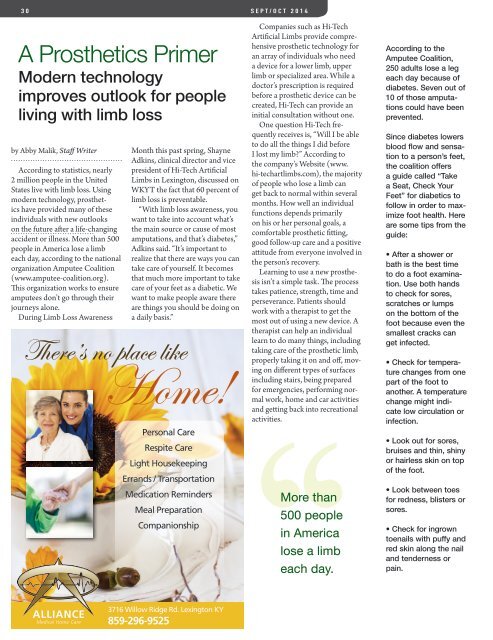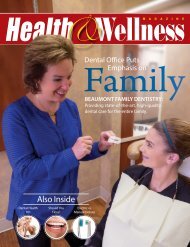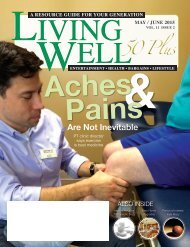Living Well 60+ September-October 2014
Create successful ePaper yourself
Turn your PDF publications into a flip-book with our unique Google optimized e-Paper software.
3 0 SEPT/OCT 2 0 1 4<br />
A Prosthetics Primer<br />
Modern technology<br />
improves outlook for people<br />
living with limb loss<br />
by Abby Malik, Staff Writer<br />
According to statistics, nearly<br />
2 million people in the United<br />
States live with limb loss. Using<br />
modern technology, prosthetics<br />
have provided many of these<br />
individuals with new outlooks<br />
on the future after a life-changing<br />
accident or illness. More than 500<br />
people in America lose a limb<br />
each day, according to the national<br />
organization Amputee Coalition<br />
(www.amputee-coalition.org).<br />
This organization works to ensure<br />
amputees don’t go through their<br />
journeys alone.<br />
During Limb Loss Awareness<br />
Month this past spring, Shayne<br />
Adkins, clinical director and vice<br />
president of Hi-Tech Artificial<br />
Limbs in Lexington, discussed on<br />
WKYT the fact that 60 percent of<br />
limb loss is preventable.<br />
“With limb loss awareness, you<br />
want to take into account what’s<br />
the main source or cause of most<br />
amputations, and that’s diabetes,”<br />
Adkins said. “It’s important to<br />
realize that there are ways you can<br />
take care of yourself. It becomes<br />
that much more important to take<br />
care of your feet as a diabetic. We<br />
want to make people aware there<br />
are things you should be doing on<br />
a daily basis.”<br />
There’s no place like<br />
Home!<br />
Personal Care<br />
Respite Care<br />
Light Housekeeping<br />
Errands / Transportation<br />
Medication Reminders<br />
Meal Preparation<br />
Companionship<br />
Companies such as Hi-Tech<br />
Artificial Limbs provide comprehensive<br />
prosthetic technology for<br />
an array of individuals who need<br />
a device for a lower limb, upper<br />
limb or specialized area. While a<br />
doctor’s prescription is required<br />
before a prosthetic device can be<br />
created, Hi-Tech can provide an<br />
initial consultation without one.<br />
One question Hi-Tech frequently<br />
receives is, “Will I be able<br />
to do all the things I did before<br />
I lost my limb?” According to<br />
the company’s Website (www.<br />
hi-techartlimbs.com), the majority<br />
of people who lose a limb can<br />
get back to normal within several<br />
months. How well an individual<br />
functions depends primarily<br />
on his or her personal goals, a<br />
comfortable prosthetic fitting,<br />
good follow-up care and a positive<br />
attitude from everyone involved in<br />
the person’s recovery.<br />
Learning to use a new prosthesis<br />
isn’t a simple task. The process<br />
takes patience, strength, time and<br />
perseverance. Patients should<br />
work with a therapist to get the<br />
most out of using a new device. A<br />
therapist can help an individual<br />
learn to do many things, including<br />
taking care of the prosthetic limb,<br />
properly taking it on and off, moving<br />
on different types of surfaces<br />
including stairs, being prepared<br />
for emergencies, performing normal<br />
work, home and car activities<br />
and getting back into recreational<br />
activities.<br />
More than<br />
500 people<br />
in America<br />
lose a limb<br />
each day.<br />
According to the<br />
Amputee Coalition,<br />
250 adults lose a leg<br />
each day because of<br />
diabetes. Seven out of<br />
10 of those amputations<br />
could have been<br />
prevented.<br />
Since diabetes lowers<br />
blood flow and sensation<br />
to a person’s feet,<br />
the coalition offers<br />
a guide called “Take<br />
a Seat, Check Your<br />
Feet” for diabetics to<br />
follow in order to maximize<br />
foot health. Here<br />
are some tips from the<br />
guide:<br />
• After a shower or<br />
bath is the best time<br />
to do a foot examination.<br />
Use both hands<br />
to check for sores,<br />
scratches or lumps<br />
on the bottom of the<br />
foot because even the<br />
smallest cracks can<br />
get infected.<br />
• Check for temperature<br />
changes from one<br />
part of the foot to<br />
another. A temperature<br />
change might indicate<br />
low circulation or<br />
infection.<br />
• Look out for sores,<br />
bruises and thin, shiny<br />
or hairless skin on top<br />
of the foot.<br />
• Look between toes<br />
for redness, blisters or<br />
sores.<br />
• Check for ingrown<br />
toenails with puffy and<br />
red skin along the nail<br />
and tenderness or<br />
pain.<br />
ALLIANCE<br />
Medical Home Care<br />
3716 Willow Ridge Rd. Lexington KY<br />
859-296-9525
















